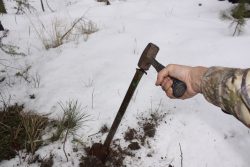Summer time may be the best time to find useful trap line tools to avoid wintertime headaches.
Different situations call for different tools. Finding a tool isn’t difficult but finding the best tool can be. Here are a list of tools I have tried and a few pros, cons and considerations that will help you decide what will be the best for your trapline:
TROWELS
Pros: Trowels are great for making pocket sets along muddy banks and for digging in rock free soils. Trowels come in a variety of sizes and shapes. They are light weight and fit in a bucket or pack basket easily.
Cons: If the ground is frozen or rocky they won’t measure up to the task. Durability can be an issue.
SOD BUSTER
Pros: This tool is dual purpose and will dig trap beds and pound stakes. This will work well in for years in the right soil conditions.
Cons: Over time I’ve had problems with the handles breaking regardless of the material they are made from. Also, the digging part of the tool seems to bend and even break when used in rocky or frozen soils.
HOE/TROWEL TOOL

Pros: This tool is also dual purpose. The hoe end will dig a trap bed quickly and the trowel end makes a dirt hole in minutes. I now carry the “badger digging tool” on my trapline and have not had any problems with its durability.
Cons: The downside may be that I also need to carry a hammer in addition to the digging tool but confidence in the durability of both make up for the extra weight.
PICK MADDOCK
Pros: It is necessary to punch through frozen ground especially when a big trap bed is needed. If this tool can’t get the job done it’s time to hang up your traps!
Cons: This tool is big, bulky and not easily transportable.
AUGER
Pros: A variety of auger type tools will allow you to make holes in the ground that are deep and straight. Cons: They won’t help you dig a trap bed so you’ll need additional digging equipment.
THREE IN ONE TOOL
Pros: Three in one tools are made with a hoe and hammer head on one end and a trowel on the other. This tool will serve the purpose for making dirt holes, digging trap beds and pounding short stakes in loose soil.
Cons: These tools are generally too small for heavy work in rocky or frozen soil conditions. These relatively small tools are not sufficient for digging big trap beds and a heavier hammer is needed for pounding long stakes.
HOME MADE TOOLS

Pros: Making your own tools will allow for a variety of options limited only by your imagination and the availability of materials. Making your own tools could be cheaper if you have scrap materials laying around.
Cons: If you have to buy steel, grinding wheels, torches and all the oxygen and acetylene to produce something that’s useable its often not cost effective. And unless you’re a skilled welder or machinist, the quality of the final product may not be sufficient.
Many digging tools will get the job done and I’ve come to the conclusion that there isn’t one digging tool that can “do it all”. I’ve also learned that not having the right tool in my hand when it’s time to get to work can add time and effort to making sets that I could use for other things. I now carry a variety of tools in my truck and make sure I carry the best tool to each set location.
There are a lot of options available to today’s trapper at affordable prices. The conditions you have along your trapline will dictate the best tool for the job. If you’re spending a lot of time `at your set locations digging trap beds and making dirt holes, think about trying a different tool that may save you time and make you money in the long run.